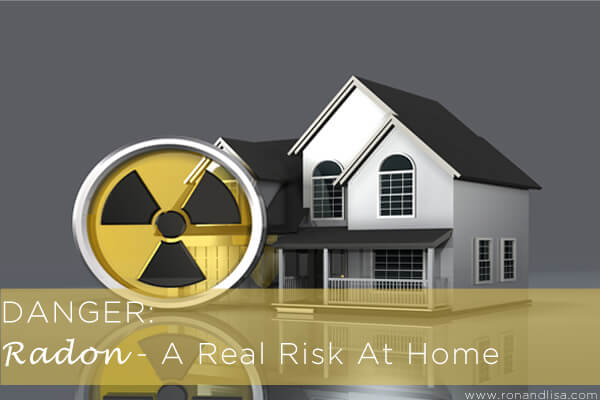Every day we hear about the possible hidden dangers lurking in and around our homes. Children living in close proximity to power lines linked to an increased risk of cancer; mesothelioma caused by inhaling asbestos; hormone imbalances and breast cancer linked to endocrine disruptors (ie: xenoestrogens); autism linked to heavy metals including mercury; and behavior problems in children, weight gain and breast & ovarian cancer linked to Bisphenol A! Phew…the list of potential dangers and risks goes on and on and may have you reaching for the nearest gas mask or hazmat suit. While many of these health risks are still being studied, none should be taken lightly. Among these very real potential hazards that can be found in homes is radon gas. While it is more common in some regions than others, radon (a known human carcinogen) poses a very serious health danger to those who are exposed to it. As the second leading cause of lung cancer in the United States, radon has led to lung cancer surpassing breast cancer as the number one cause of death among women today.
What Is Radon?
Radon is a gas which is a byproduct of the decomposition of naturally occurring uranium; a natural element found in soil, rock, and water. It is completely undetectable to the human senses: it is colorless, odorless, and tasteless. Yet, it can be found in high levels in some residences.
Where Is Radon Found?
Because it is a byproduct of the decomposition of the elements, basements of homes are the most likely locations for radon to collect. They often lack proper circulation and ventilation in them, causing radon to compound. This can create constant low to moderate exposure levels in one home, while the home next door can be completely radon free. Natural stone, such as granite, can sometimes carry normal, measurable amounts of radiation and can be particularly high in radon emissions depending on the amount of radioactive elements in the stone, where it was quarried, and how it was finished and sealed. In most cases, it is not concerning to homeowners, as the areas where granite countertops or natural stone are located are typically very well ventilated.
WATCH NOW:
Visit msnbc.com for breaking news, world news, and news about the economy
What Kinds Of Risks Are Associated With Radon Exposure?
The most common risk of exposure to radon is lung cancer. Smokers are more susceptible to being diagnosed with lung cancer if they are exposed to radon than non-smokers. However, next to smoking, radon is the most common cause of cancer throughout the world, and the number one cause of lung cancer in non-smokers. Radon is responsible for about 21,000 lung cancer deaths every year.
How Do I Know If My Home Has Radon?
The U.S. Surgeon General and EPA recommend that all homes be tested regardless of geographic location. There are a few ways to determine if your home is a radon hazard. Contact your State Radon Contact to determine what the requirements are for providing radon measurement and radon mitigations in your area. Home test kits can be purchased through your local government (residents of California can purchase these for a mere $7.95 HERE) and/or home improvement stores which are fairly effective at detecting moderately harmful levels of radon in your home. Some states even offer free or discounted test kits. While detecting moderate amounts of radon is certainly helpful, radon can be harmful over prolonged periods even at low levels. According to the U.S. Environmental Protection Agency (EPA), elevated levels of radon have been found in all across the nation. The California Department of Public Health (CDPH), and the EPA recommend that you fix your house if it has 4 picocuries per liter (4 pCi/L) or higher. Therefore, having your home tested by a hiring a certified radon measuring specialist will most likely determine whether you and your family are at risk for suffering from the negative health effects of radon.
Radon Zones
Related Articles:
Meet Atem: A Breath of Fresh Air!
12 Reasons To Add a Salt Lamp to Your Home
If My Home Has Radon, How Can I Mitigate?
The best way you can reduce levels of radon in your home is to use a contractor who is certified in radon mitigation techniques. These contractors specialize in the proper methods to reduce the amount of radon in the home, and can reduce radon levels by up to 99%. The good news is radon mitigation can be relatively inexpensive, depending on the techniques used to lower the levels in your home. Often, air exchanges and ventilation techniques including heat recovery ventilator (HRV), sub slab depressurization (SSD), and/or sealing cracks & openings will help to remediate the problem.
There are numerous hidden hazards in our homes today. These can be quite serious, and among them is radon gas. According to the EPA, nearly 1 out of every 15 homes in the U.S. has elevated radon levels. Therefore, it is important to have your home tested so you can reduce your risk of becoming ill or developing lung cancer and prevent radon gas from becoming potentially deadly for you and your family.





Radon is not something you should ignore simply because it doesn’t have an instant impact. It can be difficult to know if you or a family member has been exposed to radon gas, so, if you experiencing a radon problem ask the help of a professional.
Thanks really nice and informative article. A high concentration of radon is very risky to one’s life. . It may necessary to consult proper authorities to seek advice or to have an idea about the radon level in the place.